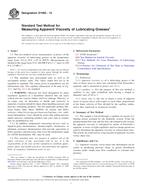We need your consent to use the individual data so that you can see information about your interests, among other things. Click "OK" to give your consent.
ASTM D1092-12
Standard Test Method for Measuring Apparent Viscosity of Lubricating Greases
STANDARD published on 1.12.2012
The information about the standard:
Designation standards: ASTM D1092-12
Note: WITHDRAWN
Publication date standards: 1.12.2012
SKU: NS-16296
The number of pages: 9
Approximate weight : 27 g (0.06 lbs)
Country: American technical standard
Category: Technical standards ASTM
The category - similar standards:
Annotation of standard text ASTM D1092-12 :
Keywords:
apparent viscosity, capillary, lubricating grease, shear rate, viscosity, ICS Number Code 75.100 (Lubricants, industrial oils and related products)
Additional information
| Significance and Use | ||||||
|
5.1 Apparent viscosity versus shear rate information can be useful in predicting pressure drops in grease distribution systems under steady-state flow conditions at constant temperature. |
||||||
| 1. Scope | ||||||
|
1.1 This test method covers measurement, in poises, of the apparent viscosity of lubricating greases in the temperature range from −54 to 38°C (−65 to 100°F). Measurements are limited to the range from 25 to 100 000 P at 0.1 s−1 and 1 to 100 P at 15 000 s−1. 1.2 This standard uses inch-pound
units as well as SI (acceptable metric) units. The values stated
first are to be regarded as standard. The values given in
parentheses are for information only. The capillary dimensions in
SI units in 1.3 WARNING—Mercury has been designated by
many regulatory agencies as a hazardous material that can cause
central nervous system, kidney and liver damage. Mercury, or its
vapor, may be hazardous to health and corrosive to materials.
Caution should be taken when handling mercury and mercury
containing products. See the applicable product Material Safety
Data Sheet (MSDS) for details and EPA’s
website—http://www.epa.gov/mercury/faq.htm—for additional
information. Users should be aware that selling mercury and/or
mercury containing products into your state or country may be
prohibited by law.
1.3.1 In addition, temperature measuring devices such as liquid-in-glass thermometers, thermocouples, thermistors, or platinum resistance thermometers that provide equivalent or better accuracy and precision, that cover the temperature range for ASTM thermometer 49C, may be used. 1.4 This standard does not purport to address all of the safety concerns, if any, associated with its use. It is the responsibility of the user of this standard to establish appropriate safety and health practices and determine the applicability of regulatory limitations prior to use. |
||||||
| 2. Referenced Documents | ||||||
|
Similar standards:
Historical
1.10.2011
Historical
1.5.2013
Historical
1.11.2012
Historical
15.6.2013
Historical
1.12.2011
Historical
1.6.2012
We recommend:
Technical standards updating
Do you want to make sure you use only the valid technical standards?
We can offer you a solution which will provide you a monthly overview concerning the updating of standards which you use.
Would you like to know more? Look at this page.



 ASTM D7155-11
ASTM D7155-11 ASTM D7156-13
ASTM D7156-13 ASTM D7214-07a(2012)..
ASTM D7214-07a(2012).. ASTM D7216-13
ASTM D7216-13 ASTM D7217-11
ASTM D7217-11 ASTM D7260-12
ASTM D7260-12
 Cookies
Cookies
